Gilbane, the family owned construction and real estate development firm, is predicting stronger spending on nonresidential building this year, even if the number of projects started doesn’t appreciate significantly.
“Even if new starts growth were to turn flat for the rest of 2015 (which is not expected), those starts already recorded over the past 12 months indicate spending for nonresidential buildings in 2015 will increase 15% over 2014, the best growth since 2007,” writes the company in its “Building For the Future” Spring report on Construction Economics and Market Conditions.
Gilbane estimates that total spending for nonresidential building construction will reach $370 billion this year, a 15.3% increase. The company expects nonresidential starts to slow in 2015 but still hit 218,052 units, 7.4% ahead of the previous year.

Educational building is expected to account for 22.7% of total nonresidential construction spending in 2015, down from its 24.4% market share in 2014 and 30.3% in 2010. Still, Gilbane foresees spending on educational building to be up 7% this year, to $83.8 billion, the first substantial increase since 2008.
The manufacturing sector, whose market share of total nonresidential construction spending is projected to be flat at 17.2% this year, should see its spending amounts increase by 15% to $63.5 billion, which would be on top of a 15% gain in 2014. Spending on office construction is expected to grow 17.5% to $52.6 billion. And construction spending on commercial retail will be up 12.5% to $64.2 billion.
Gilbane projects that nonresidential construction revenue will increase by 9.1%. However, using historical benchmarks as its guide, the company believes that at least half of that gain could be attributable to “rapidly increasing inflation,” which had grown by 11% in the previous three years.

As other industry watchers have noted, Gilbane isn’t seeing much inflation on the materials side, with some exceptions like gypsum and precast concrete. Gilbane is more concerned, though, about construction hiring trends.
As of March 2015, there were 6.344 million construction employees, according to Bureau of Labor Statistics’ data. The unemployment rate in construction is now at 9.5% after hitting a low of 6.4% in October 2014. Total hiring in the construction industry was up by an estimated 15% in the first quarter of this year.
Gilbane believes that companies aren’t always using the right metrics to determine their hiring levels.
It notes that since 2012, the number of workers to complete $1 billion of constant volume has increased from about 5.65 million to 6.1 million. That would imply an 8% loss in productivity in three years. But Gilbane insists this “loss” has more to do with overall cost reductions than with projects being over-staffed.
“Workload volume should be used for planning the size of the workforce,” Gilbane states. “As an example, at the 2008 peak of construction cost, a building cost $12 million and took 100 men per year to build. In 2010, that same building potentially cost as little as $10 million to build, 20% less. Did it take 20% fewer men per year to build it? No, certainly not. That would be the fallacy of trying to determine jobs needed based on unadjusted revenue.”
To bolster its argument, Gilbane notes that historical averages (adjusted for inflation) since year 2000 show the number of direct construction jobs supported by $1 billion in construction spending varies +/- from 6,000 jobs. That calculates to one job for every $165,000 (in 2014 dollars) spent on construction, or 6.0 to 7.0 jobs per $1,000,000 spent.
Related Stories
Multifamily Housing | Jun 1, 2015
Sacramento moves forward on multifamily project with new modular supplier
Guerdon Modular Buildings will provide modules for 118 apartments.
BIM and Information Technology | May 27, 2015
4 projects honored with AIA TAP Innovation Awards for excellence in BIM and project delivery
Morphosis Architects' Emerson College building in Los Angeles and the University of Delaware’s ISE Lab are among the projects honored by AIA for their use of BIM/VDC tools.
Healthcare Facilities | May 27, 2015
Rochester, Minn., looks to escape Twin Cities’ shadow with $6.5 billion biotech development
The 20-year plan would also be a boon to Mayo Clinic, this city’s best-known address.
BIM and Information Technology | May 21, 2015
How AEC firms should approach BIM training
CASE Founding Partner Steve Sanderson talks about the current state of software training in the AEC industry and common pitfalls in AEC training.
Architects | May 20, 2015
Architecture billings remain stuck in winter slowdown
Regional business conditions continue to thrive in the South and West
University Buildings | May 19, 2015
Special Report: How your firm can help struggling colleges and universities meet their building project goals
Building Teams that want to succeed in the higher education market have to help their clients find new funding sources, control costs, and provide the maximum value for every dollar.
University Buildings | May 19, 2015
Renovate or build new: How to resolve the eternal question
With capital budgets strained, renovation may be an increasingly attractive money-saving option for many college and universities.
University Buildings | May 19, 2015
KU Jayhawks take a gander at a P3 development
The P3 concept is getting a tryout at the University of Kansas, where state funding for construction has fallen from 20% of project costs to about 11% over the last 10 years.
Retail Centers | May 18, 2015
ULI forecast sees clear skies for real estate over next three years
With asset availability declining in several sectors, rents and transactions should rise.
Architects | May 10, 2015
Harness the connection between managing risk and increasing profitability, Part 2
In Part 1, we covered taking control of the submittals schedule and managing RFIs. Let’s move on to properly allocating substitutions and limiting change orders.















